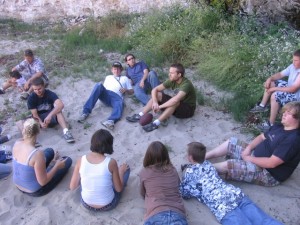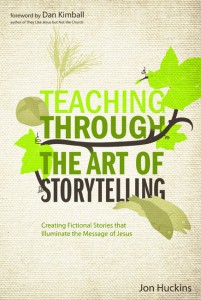Today, we move from the nitty-gritty character/plot development of the first two parts and move into the art of integrating Scripture/theology into the story. If you missed early parts of the story, here you go: Intro, Part 1, Part 2.
The next day, a well-dressed older fellow walked into Kevin’s jail cell. Kevin hadn’t said a word since the events of the day before. The man looked Kevin in the eye and said, “My name is Doug. I’ll be representing you as your attorney. Cory died last night at the hospital. Since you turned eighteen last week, you’ll be tried as an adult.”
Kevin felt paralyzed by this news. What had happened to his life? How could he be facing a life sentence in prison? Was there something he was missing?
Someone had to be blamed for this situation. How about Doug? Kevin thought. No, he did a good job representing me; it just didn’t work out like he’d hoped. How about my sister? No, she never asked me to defend her, and I don’t think she did sleep with all of those guys. Could it have been my fault? Not a chance. I only did what I needed to do. Plus, that’s how I was taught to handle conflict growing up . . . growing up! That’s it! My parents—they’re the ones to blame. They knew something like this would happen to me, and they didn’t say a thing! All of my life I saw only revenge, violence, and anger. This is all their fault.
Kevin’s bitterness toward his parents grew every day. As a result he isolated himself from everyone. This is what had become of him. He was serving a life sentence in prison, and he had no desire to communicate with anyone, not even his family.
That is, until Kevin met a guy named Charlie.
Charlie knew Kevin didn’t want to talk, but after seeing Kevin sitting by himself at every meal for over a year, he sat down across the table from him anyway. Kevin didn’t look up, so Charlie simply said hello and introduced himself. He already knew Kevin’s name, so he didn’t bother asking. In fact, Charlie didn’t ask Kevin any questions; he just started telling his story.
Charlie had lived a simple life in a small mountain town. When he was twenty-one years old, he ran into an old friend who was back in town for the week visiting family and friends. Apparently his friend had some enemies because while they were eating dinner at a restaurant, someone started shouting at him to get out of town. Charlie wasn’t sure what the story was. But he figured that if this guy wanted to yell, then they’d yell back. They started fighting; and after getting punched in the face, Charlie picked up a chair and slammed it over the guy’s head. Somehow the chair hit the man’s temple, and he died instantly. Now Charlie was in prison with a life sentence.
Although Kevin was still looking down and pretending to be interested in his dinner, he heard every word. Charlie continued, “I’ve learned a lot as a result of that night, Kevin. Maybe sometime we could talk more about it. And I’d be interested to hear your story as well.” That was the first time anyone had paid any attention to Kevin.
The next afternoon Charlie came up to Kevin again while the inmates were outside in the courtyard. Kevin was sitting against a chain-link fence, and Charlie sat down right next to him. They didn’t say much, but Kevin found himself appreciating the company. All of a sudden, Kevin started talking. He had no idea where it was coming from, but he just felt the need to tell his story. So he did. He discussed his childhood leading all the way up to the day he killed Cory. And he told Charlie about all of the bitterness he had toward his family, especially his parents. Kevin also shared about the guilt he carried around with him every day for murdering Cory.
It was like a small weight had been lifted off Kevin’s shoulders. Even so, Kevin still remained hostile toward the other guys in the prison, and he began picking fights with anyone who seemed like an “enemy.” It was as though he was transitioning from a quiet, isolated, and bitter person back into the angry, hostile person of his youth.
One day while they were back outside in the courtyard, Charlie pulled Kevin aside and began telling him another story—about this guy, Jesus, and his revolutionary way of dealing with people who disagreed with him or meant to harm him. Kevin had seen Bibles on TV before when those crazy preachers were on at 2 a.m. But when Charlie pulled his Bible from his pocket, it was the first time Kevin had seen one in person. Charlie opened his Bible to Matthew 5:38–42 and told Kevin that this was how Jesus taught his followers to respond to injustice:
You have heard that it was said, “Eye for eye, and tooth for tooth.” But I tell you, Do not resist an evil person. If someone strikes you on the right cheek, turn to him the other also. And if someone wants to sue you and take your tunic, let him have your cloak as well. If someone forces you to go one mile, go with him two miles. Give to the one who asks you, and do not turn away from the one who wants to borrow from you.
Charlie began to explain that when Jesus said these words, the Roman Empire ruled the land, and Israel was a small minority tha t was supposed to change the world as God’s “chosen people.” The Roman soldiers would often humiliate the Israelites as an act of lording their power over a submitted people. But in this passage Jesus suggests a creative third way of responding to the injustice that the Romans imposed on the less powerful.
t was supposed to change the world as God’s “chosen people.” The Roman soldiers would often humiliate the Israelites as an act of lording their power over a submitted people. But in this passage Jesus suggests a creative third way of responding to the injustice that the Romans imposed on the less powerful.
Then Charlie said, “When I was growing up, I thought there were only two ways to respond to someone who tried to hurt me: I could either react passively and let the person beat me up, or I could fight back with the same violence they offered me. Through Jesus’ words and example, however, I’ve found there’s a third way that allows me to keep my dignity as a human being but doesn’t compromise my morals by fighting back—like I did when I killed a man and received a lifelong prison sentence.”
Charlie continues, “You see, Kevin, Jesus fights for equality, justice, and humanity while his third-way response exposes a disjointed and violent culture. Jesus isn’t asking us to just ‘take it’ (which is version of pacifism), but he also doesn’t want us grabbing a sword and retaliating (which is violence). Our culture offers us only two ways—but Jesus’ third way means we turn our oppressors’ tactics on their heads whenever we take action like turning the other cheek, offering all that we have, and walking the extra mile. When we do this, their strategies lose their power, and our humanity is restored.
“You know how many movies have to do with a ‘good guy’ getting back at a ‘bad guy’ who’s done some form of injustice? Well, these movies promote what I call redemptive violence—the myth that responding to violence with violence makes things right. But redemption means to rescue or reclaim—it has nothing to do with violence.”
Charlie hoped he hadn’t said too much. But he could tell Kevin was actively listening, even though he never made eye contact. This was the first time Kevin had ever heard anything like this. He was very intrigued with this myth of “redemptive violence,” as Charlie called it. But he struggled to see Jesus’ third way as a realistic response. It required forgiveness and humility, and Kevin wasn’t ready to embrace that just yet.
follow-up Questions
Do you ever hold onto bitterness and try to do life alone?
Do you have a “Charlie” in your life who you’ve rejected or who you’ve allowed to be a part of your life?
What are our culture’s options for responding to someone who hurts us?
What would it look like to enact this third-way response?
What move can you make that will remind others that you’re human?


